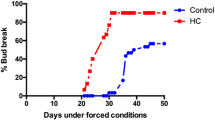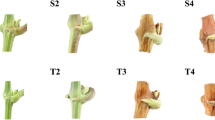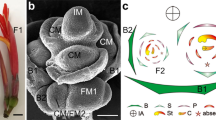Abstract
Grapevine bud fruitfulness is determined by the differentiation of uncommitted meristem (UCM) into either tendril or inflorescence. Since tendril and inflorescence differentiation have long been considered sequential steps in inflorescence development, factors that control the progression of floral meristem development may regulate the final outcome of UCM differentiation, and thus affect fruitfulness. A comparison of the expression profiles of the master regulators of floral meristem identity (FMI) during development of fruitful and non-fruitful buds along the same cane allowed associating the expression of a homolog of terminal flower 1 (TFL1, a negative regulator of FMI) to fruitful buds, and the expression of positive FMI regulators to non-fruitful buds. Combined with (a) cytokinin-induced upregulation of VvTFL1A expression in cultured tendrils, which accompanied cytokinin-derived tendril transformation into branched, inflorescence-like structures, (b) positive regulation of VvTFL1A expression by cytokinin, which was demonstrated in transgenic embryonic culture expressing GUS reporter under the control of VvTFL1A promoter, and (c) a significantly higher level of active cytokinins in fruitful positions, the data may support the assumption of cytokinin-regulated VvTFL1A activity’s involvement in the control of inflorescence development. Such activity may delay acquisition of FMI and allow an extended branching period for the UCM, resulting in the differentiation of inflorescence primordia.








Similar content being viewed by others
Abbreviations
- AP1:
-
Apetala1
- CEN:
-
Centroradialis
- FMI:
-
Flower meristem identity
- FT:
-
Flowering locus 1
- GA:
-
Gibberellic acid
- GFP:
-
Green fluorescent protein
- GUS:
-
Beta-glucoronidase
- LFY:
-
Leafy
- RRM:
-
Reiterated reproductive meristem
- SAM:
-
Shoot apical meristem
- TFL1:
-
Terminal flower 1
- UCM:
-
Uncommitted meristem
- Vv:
-
Vitis vinifera
References
Benlloch R, Berbel A, Serrano-Mislata A, Madueño F (2007) Floral initiation and inflorescence architecture: a comparative view. Ann Bot 100:659–676
Blázquez MA, Ferrandiz C, Madueño F, Parcy F (2006) How floral meristems are built. Plant Mol Biol 60:855–870
Boss PK, Thomas MR (2002) Association of dwarfism and floral induction with a grape ‘green revolution’ mutation. Nature 416:847–850
Boss PK, Buckeridge EJ, Pool A, Thomas MR (2003) New insights into grapevine flowering. Funct Plant Biol 30:593–606
Boss PK, Sreekantan L, Thomas MR (2006) A grapevine TFL1 homologue can delay flowering and alter floral development when overexpressed in heterologous species. Funct Plant Biol 33:31–41
Bradley D, Carpenter R, Copsey L, Vincent C, Rothstein S, Coen E (1996) Control of inflorescence architecture in Antirrhinum. Nature 379:791–797
Bradley D, Ratcliffe O, Vincent C, Carpenter R, Coen E (1997) Inflorescence commitment and architecture in Arabidopsis. Science 275:80–83
Buttrose MS (1974) Climatic factors and fruitfulness in grapevines. Hortic Abstr 44:319–326
Calonje M, Cubas P, Martinez-Zapater JM, Carmona MJ (2004) Floral meristem identity genes are expressed during tendril development in grapevine. Plant Physiol 135:1491–1501
Carmona MJ, Cubas P, Martinez-Zapater JM (2002) VFL, the grapevine FLORICAULA/LEAFY ortholog, is expressed in meristematic regions independently of their fate. Plant Physiol 130:68–77
Carmona MJ, Calonje M, Martínez-Zapater JM (2007a) The FT/TFL1 gene family in grapevine. Plant Mol Biol 63:637–650
Carmona MJ, Cubas P, Calonje M, Martínez-Zapater JM (2007b) Flowering transition in grapevine (Vitis vinifera L.). Can J Bot 85:701–711
Carmona MJ, Chaib J, Martínez-Zapater JM, Thomas MR (2008) A molecular genetic perspective of reproductive development in grapevine. J Exp Bot 59:2579–2596
Conti L, Bradley D (2007) TERMINAL FLOWER1 is a mobile signal controlling Arabidopsis architecture. Plant Cell 19:767–778
Coombe BG (1967) Effects of growth retardants on Vitis vinifera L. Vitis 6:278–287
Danilevskaya ON, Meng X, Ananiev EV (2010) Concerted modification of flowering time and inflorescence architecture by ectopic expression of TFL1-like genes in maize. Plant Physiol 153:238–251
Dobrev PI, Kaminek M (2002) Fast and efficient separation of cytokinins from auxin and abscisic acid and their purification using mixed-mode solid-phase extraction. J Chromatogr A950:21–29
Dry PR (2000) Canopy management for fruitfulness. Aust J Grape Wine Res 6:109–115
Fernandez L, Torregrosa L, Segura V, Bouquet A, Martinez-Zapater JM (2010) Transposon-induced gene activation as a mechanism generating cluster shape somatic variation in grapevine. Plant J 61:545–557
Giakountis A, Coupland G (2008) Phloem transport of flowering signals. Curr Opin Plant Biol 11:687–694
Gottlieb Y, Ghanim M, Chiel E, Gerling D, Portnoy V, Steinberg S, Tzuri G, Horowitz AR, Belausov E, Mozes-Daube N, Kontsedalov S, Gershon M, Gal S, Katzir N, Zchori-Fein E (2006) Identification and localization of a Rickettsia sp. in Bemisia tabaci (Homoptera: Aleyrodidae). Appl Environ Microbiol 72:3646–3652
Guan CM, Zhu SS, Li XG, Zhang XS (2006) Hormone-regulated inflorescence induction and TFL1 expression in Arabidopsis callus in vitro. Plant Cell Rep 25:1133–1137
Halaly T, Pang X, Batikoff T, Crane O, Keren A, Venkateswari J, Ogrodovitch A, Sadka A, Lavee S, Or E (2008) Similar mechanisms might be triggered by alternative external stimuli that induce dormancy release in grape buds. Planta 228:79–88
Jefferson RA, Kavanagh TA, Bevan MW (1987) GUS fusions: beta-glucuronidase as a sensitive and versatile gene fusion marker in higher plants. EMBO J 6:3901–3907
Joly D, Perrin M, Gertz C, Kronenberger J, Demangeat G, Masson JE (2004) Expression analysis of flowering genes from seedling-stage to vineyard life of grapevine cv. Riesling. Plant Sci 166:1427–1436
Lavee S, Regev U, Samish RM (1967) The determination of induction and differentiation in grape vines. Vitis 6:1–13
May P (2004) Flowering and fruitset in grapevines. Lythrum Press, Adelaide
Mohamed R, Wang CT, Ma C, Shevchenko O, Dye SJ, Puzey JR, Etherington E, Sheng X, Meilan R, Strauss SH, Brunner AM (2010) Populus CEN/TFL1 regulates first onset of flowering, axillary meristem identity and dormancy release in Populus. Plant J 62:674–688
Morrison JC (1991) Bud development in Vitis vinifera L. Bot Gaz 152:304–315
Mullins MG, Bouquet A, Williams LE (1992) Biology of the grapevine. Cambridge University Press, UK
Nakagawa M, Shimamoto K, Kyozuka J (2002) Overexpression of RCN1 and RCN2, rice TERMINAL FLOWER/CENTRORADIALIS homologs, confers delay of phase transition and altered panicle morphology in rice. Plant J 29:743–750
Perl A, Eshdat Y (2007) Grapes. In: Pua EC, Davey MR (eds) Biotechnology in agriculture and forestry—transgenic crops V, vol 60. Springer-Verlag, Berlin, pp 189–208
Pratt C (1971) Reproductive anatomy in cultivated grapes—a review. Am J Enol Vitic 22:92–109
Pratt C (1974) Vegetative anatomy in cultivated grapes—a review. Am J Enol Vitic 25:131–150
Ratcliffe OJ, Amaya I, Vincent CA, Rothstein S, Carpenter R, Coen ES, Bradley DJ (1998) A common mechanism controls the life cycle and architecture of plants. Development 125:1609–1615
Ratcliffe OJ, Bradley D, Coen ES (1999) Separation of shoot and floral identity in Arabidopsis. Development 126:1109–1120
Reid KE, Olsson N, Schlosser J, Peng F, Lund ST (2006) An optimized grapevine RNA isolation procedure and statistical determination of reference genes for real-time RT-PCR during berry development. BMC Plant Biol 6:27
Shannon S, Meeks-Wagner DR (1991) A mutation in the Arabidopsis TFL1 gene affects inflorescence meristem development. Plant Cell 3:877–892
Simon R, Igeno MI, Coupland G (1996) Activation of floral meristem identity genes in Arabidopsis. Nature 384:59–62
Sreekantan L, Thomas MR (2006) VvFT and VvMADS8, the grapevine homologues of the floral integrators FT and SOC1, have unique expression patterns in grapevine and hasten flowering in Arabidopsis. Funct Plant Biol 33:1129–1139
Srinivasan C, Mullins MG (1976) Reproductive anatomy of the grape-vine (Vitis vinifera L.): origin and development of anlage and its derivatives. Ann Bot 38:1079–1084
Srinivasan C, Mullins MG (1978) Control of flowering in the grapevine (Vitis vinifera L.). Plant Physiol 61:127–130
Srinivasan C, Mullins MG (1980a) Effects of temperature and growth regulators on formation of anlagen, tendrils and inflorescences in Vitis vinifera L. Ann Bot 45:439–446
Srinivasan C, Mullins MG (1980b) Flowering in Vitis: effects of genotype on cytokinin-induced conversion of tendrils into inflorescences. Vitis 19:293–300
Srinivasan C, Mullins MG (1981) Physiology of flowering in the grapevine—a review. Am J Enol Vitic 32:47–61
Sugiura A, Utsunomiya N, Tomana T (1976) Induction of inflorescence by CCC application on primary shoots of grapevines. Vitis 15:88–95
Takada S, Goto K (2003) TERMINAL FLOWER2, an Arabidopsis homolog of HETEROCHROMATIN PROTEIN1, counteracts the activation of FLOWERING LOCUS T by CONSTANS in the vascular tissues of leaves to regulate flowering time. Plant Cell 15:2856–2865
Tamaki S, Matsuo S, Wong HL, Yokoi S, Shimamoto K (2007) Hd3a protein is a mobile flowering signal in rice. Science 316:1033–1036
Turck F, Fornara F, Coupland G (2008) Regulation and identity of florigen: FLOWERING LOCUS T moves center stage. Annu Rev Plant Biol 59:573–594
Author information
Authors and Affiliations
Corresponding author
File S1. Expression summary. Summary of published expression analyses of VFL, VAP1, VvTFL1A and VvFT in grapevine
Below is the link to the electronic supplementary material.
Rights and permissions
About this article
Cite this article
Crane, O., Halaly, T., Pang, X. et al. Cytokinin-induced VvTFL1A expression may be involved in the control of grapevine fruitfulness. Planta 235, 181–192 (2012). https://doi.org/10.1007/s00425-011-1497-6
Received:
Accepted:
Published:
Issue Date:
DOI: https://doi.org/10.1007/s00425-011-1497-6




